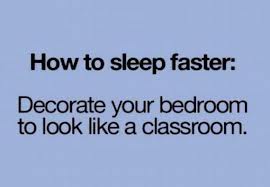Dr. V.K.Maheshwari, M.A. (Socio, Phil) B.Sc. M. Ed, Ph.D. Former Principal, K.L.D.A.V.(P.G) College, Roorkee, India
Mrs Sudha Rani Maheshwari, M.Sc (Zoology), B.Ed. Former Principal.A.K.P.I.College, Roorkee, India
Some people talk in their sleep. Lecturers talk while other people sleep.
-Albert Camus
Sleep is a natural periodic state of rest for the mind and body, in which the eyes usually close and consciousness is completely or partially lost, so that there is a decrease in bodily movement and responsiveness to external stimuli. During sleep the brain in humans and other mammals undergoes a characteristic cycle of brain-wave activity that includes intervals of dreaming.
According to a simple behavioral definition, sleep is a reversible behavioral state of perceptual disengagement from and unresponsiveness to the environment. It is also true that sleep is a complex amalgam of physiologic and behavioral processes. Sleep is typically (but not necessarily) accompanied by postural recumbence, behavioral quiescence, closed eyes, and all the other indicators one commonly associates with sleeping. In the unusual circumstance, other behaviors can occur during sleep. These behaviors can include sleepwalking, sleep-talking, teeth grinding, and other physical activities. Anomalies involving sleep processes also include intrusions of sleep—sleep itself, dream imagery, or muscle weakness—into wakefulness
There is no sharp line between sleep and waking. Though in sleep we commonly lie relaxed in body, and sometimes, it would seem, entirely inactive in mind, at other times we move and even walk about in sleep, and frequently we think, or are mentally active, in the peculiar way we call dreaming. For many of us, sleep is the sweet balm that soothes and restores us after a long day of work and play. But for those for whom sleep is elusive or otherwise troubled, the issue is far more fraught. Most people, at some point in their lives, experience difficulty falling asleep. Other parasomnias—such as sleep apnea, night terrors, , and sleep paralysis—are surprisingly common There is no physiological condition known to be invariably present in, or necessary to sleep.
Conditions conducive to sleep
There can be various conditions that conduce to sleep without being essential to it. Such are :
v The most important single condition of sleep is, perhaps peace of mind. Without this we may, if tired, fall asleep; but we are then apt to waken when but partially refreshed. If we go to bed with a guilty conscience, or with some project” seething in the brain, “ or thinking of some object we strongly desire but can not attain, or reflecting upon recent triumphs or humiliations, or on any other emotionally exiting topic, we do not easily fall asleep, and we readily waken again. Under such conditions, even though we be tired, the ratio of resistances to free energy remains low, because the free energy is so abundantly maintained by the endogenous activities of the brain. In such cases we may lie long hours thinking mainly of the exiting topic; until at last a deeper-lying form of fatigue sets in; the instinctive source of energy that sustains our involuntary thinking seems to dry up from exhaustion and we sink into profound sleep.
v A diminished flow of blood to the brain (as by food to the stomach, attracting blood to the digestive organs )
v The absence of strong sensory stimuli: a healthy man may sleep in a brightly lit room full of rattle and uproarious music parties ; yet strong sense-stimuli may conduce.
v General relaxation of muscles conduces to sleep; yet some times when we are very tired we can not sleep, and some man can sleep at will when not fatigued.
v The general-fatigue factor is, in the main, the general chemical factor which may be increased by alcohol.
v Sensations of fatigue favors sleep; and among such fatigue-sensations those of the eyelids, and perhaps the eyeballs, have the greatest influence.
v The most obscure facto conducing to sleep is the desire or will to sleep. We have a certain power both to sleep and to waken; some can exercise it much more effectively than others.
v ‘Suggeestion’ may aid or hinder sleep; and confident expectation of sleep, aided by the familiar surroundings of the bedroom is of no small influence.
All this goes to show that the onset of sleep is not, is not always, a passive lapsing of mental activity when conditions favour sleep; it suggests rather that in falling asleep there is, or may be on some occasions, a conative factor at work.If falling asleep is subject to the will and is to some extent a purposive activity or process, one which tends to occour under certain external bodily conditions, and yet is subject in some degree to the will, we may rightly suspect that it is an instinctive process.
As in normal circumstances sleep precedes exhaustion, and as in many cases exhaustion produces insomnia, we infer that sleep is a function of defense, an instinct which has for its goal, in striking the animal with inertia, to forbid it to arrive at the stage of exhaustion, it is not because we are intoxicated or exhausted that we sleep, but we sleep in order to avoid becoming intoxicated or exhausted.
All these facts indicates that falling asleep is an instinctive process. We can find confirmation of this theory in analogies with hypnosis and various animal phenomena, more especially the undoubtly instinctive process of hibernation.
This way sleep is the consequence of a functional activity of continuous nature and demanding in order to be initiated, to be put in train a more considerable energy than to be continued, once the impulsion has been given.But that is the case with all our activities, voluntary actions are most commonly voluntary only at their inception, the effot consists in deciding upon them, in beginning them, and thereafter the movements continue of themselves in a quasi-automatic fashion.
To conclude, we may suppose that this obscure instinctive process has, like others, its sensory cues, this obscure instinctive process has, like others, itssensory cues, and these cues seem to be fatigue-sensations in general, and more especially those localized in the muscles of eyelids and eyeballs. The primary effect of bringing the instinct into play is an impulse to close the eyes, with correlated inhibition of the muscles that keep them open, and perhaps of all other muscles of the skeletal system, and perhaps there are corresponding nervous current sent to various visceral organs, currents that bring the circulation of the blood and other organic processes into a state favourable to sleep. Perhaps also there is actual inhibition of all higher brain-processes.
Condition of the Brain in Sleep
Whether or no we accept this theory of the instinctive factor in the process of falling asleep, we may with some confidence describe the state of the brain of the queitet sleeper as one of relative general dissociation. There are fatigue products in the blood which maintain the synaptic resistances at a comparatively when the curve of sleep (as measured by the intensity of stimuli required to waken the sleeper) is commonly deepest. This curve of sleep normally rises gradually in the morning hours; that is to say, sleep becomes less profound, more easily interrupted; a fact we may attribute in the main to the passing away of the poisonous waste-products of activity.
But the high resistances of the synapses, the relative dissociation of neurons and neuron systems, is due to a second factor also. When sleep has been attained, the mind is relatively at rest; in sound sleep our instinctive emotional activities are normally in abeyance, or at very low ebb; that is to say, little if any energy is liberated from the instinctive dispositions. During waking hours energy is constantly liberated from the various instinctive dispositions and floods the brain, discharging itself in various efferent channels. There is good reason to believe that the presence of free energy in any neurone system keeps down the resistances of the synapses within that system. When, then, in sleep the instinctive activities dispositions located mainly in the thalamus of the lower brain. The flood of free energy subsides from the cerebrum like a ebbing tide, leaving its channels comparatively empty of free energy and its resistances relatively high; that is to say, it leaves the cerebrum in a state of relative dissociation, in which its various functional units cannot easily play upon one another. After a long sleep, when all waste products are removed and the partially exhausted stores of latent energy are renewed, the afferent energies liberated by sense-stimuli begin again to penetrate to the cerebrum and thus to bring the state of sleep to an end.
Sleep is triggered by a complex group of hormones that are active in the main, and that respond to cues from the body itself and the environment.
It is true that the movements we dream of making are sometimes realized, incipiently and partially, or completely as in the somnabulists; just as the sense-impressions we receive do someti8mes penetrate to the cerebrum and affect the course of our dreaming. At present no satisfactory answer is to be found along the following lines. In dreaming the instinctive dispositions are at work and energy circulates in the cerebrum; in waking life; all activity proceeds on a lower plane of activity, and the dream-activity involves only relatively restricted tracts of the brain; hence the efferent outflow also is relatively feeble, insufficient to overcome the raised resistances of the synapses leading to the pyramidal tract and other efferent channels.


